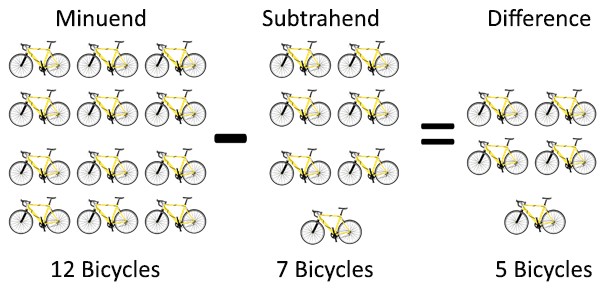Exploring subtrahend
The discussion in the previous Learning Outcome has already well-introduced us to the idea of the subtrahend. Subtrahend is the quantity in all subtraction expressions that is reduced/subtracted from the minuend. For example, in the subtraction expression 12 bicycles – 7 bicycles = 5 bicycles, 7 bicycles are considered the subtrahend in the subtraction expression.

Subtrahend is the dynamic part of subtraction - while there is only one minuend in a subtraction expression, it is possible to have multiple subtrahends. It reflects how any given quantity (minuend) is being used, wasted, compared, and loaned away (any of these things can be the reason for reducing the quantity of a given minuend).
Let us consider the expression 15 – 5 – 3 – 2 – 1 - 4
In the above mentioned expression, the numbers ‘5’, ‘3’, ‘2’, ‘1’ and ‘4’ are being subtracted from the first number (15) ; ‘5’, ‘3’, ‘2’, ‘1’ and ‘4’ are subtrahend.

Now let us get to know some more specific characteristics of the subtrahend.
Broadly, the subtrahend is a part of the quantity of things that is the minuend.
Subtrahend could be simple or compound; it is simple when there is one subtrahend quantity. It is compound when there are more than one subtrahend quantities.
Subtrahend in an expression is eventually the total of the multiple subtrahends; we represent all the subtrahend as one by replacing all of the subtrahends with their sum. There is only one subtrahend in a subtraction expression that is directly operable.
Subtrahend could be of any of the following three origins:
- It is the quantity taken away from the minuend.
- It is the quantity separately identified in the minuend.
- It is the measure of the characteristic of another thing that is being compared to the measurement of the same characteristic of the thing that is the minuend.
The total quantity of subtrahends in a given subtraction expression can never be more than the quantity of minuend.
In the case of multiple subtrahends, each subtrahend quantity is a record of change in the quantity of minuend, or it is the record of every comparison of multiple comparisons.
When subtrahend represents the quantity of usage - (takeaway)/wastage/giveaway, it is always in the same unit as the minuend. However, this does not mean that the actual usage/wastage/loan is the same as the minuend unit. Let us understand this through a couple of examples:
The given minuend = 5 packets of chocolates (with 5 small bars in each packet)
Each usage could be less than a bar, 1 bar, 2 bars, 3 bars, 4 bars, 5 bars (1 packet), 2 packets, or any other quantity.
The subtraction expression in this case (with minuend expressed in packets) will be such that each subtrahend will be expressed in terms of packets (the unit of the minuend).
Let the usages be 1 bar, 2 bars, 3 bars, 2 bars, 1 packet.
Thus, the subtraction expression will be –
5 packets – 1/5 packets – 2/5 packets – 3/5 packets – 2/5 packets – 1 packet (i.e., 5 bars)
Note: Do not worry about using fractions here as long as it can be appreciated that 5 bars = 1 packet, so 1 bar = one of the 5 parts of a packet = 1/5. Thus, 1 bar = 1/5 packet, 2 bars = 2 x 1/5 = 2/5 packets.
However, the same is true for minuend also – we can change the unit of minuend also to be the same as the unit of the subtrahend (this is done by changing the quantity of the minuend). Thus, for the aforementioned example, we can also write the subtraction expression in terms of the unit of the subtrahend, i.e., bars, as under:
25 bars – 1 bar – 2 bars – 3 bars – 2 bars – 5 bars
Indeed, subtrahend and minuend are closely related.
Some everyday examples of subtrahend are:
- All the expenses in a day (if the expenses are recorded for each day)
- Pages read in a book in a day (if we want to know the days taken to finish reading the book)
- Fruits removed from the dining table basket due to spoilage
- Crayons lost
- Medicines eaten in a day (from a strip of the medicine)
Do appreciate that each quantity is a subtrahend because of its context (i.e., there is a definable minuend in each example).
Summary
Subtrahend is the dynamic part of subtraction expression, shows the ‘actions’ on the stock of a thing (minuend). Subtrahend and minuend are closely related. If we change the units of the quantities in minuend, the quantities in subtrahend also change and vice versa.Excerpted from the book ‘Foundations of Subtraction (Mathematics as a language)’ by Sandeep Srivastava and Saloni Srivastava
